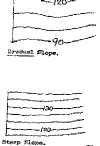Map reading is an art. Spend some time just sitting at home looking at various maps and learn to read them like a picture book.
Which Map?
The first thing that you have to decide is what scale of map is suited to your purpose.
The scale of the map is always printed on the front cover and is expressed as the ratio between a unit of length on the map and the equivalent distance on the ground.
The scale of 1:25,000 means that one unit of length on the map is equivalent to 25,000 units on the ground, or, to put it into actual units, one centimeter is equivalent to 25,000 centimeters or 250 meters.
In the same way 1:50,000 means that 1cm on the map is equivalent to 50,000 centimeters or 500 meters on the ground.
Some common map scales and their uses:
Scale |
Meaning |
Use |
| 1:10,000 | 1cm= 100m | Orienteering |
| 1:25,000 | 1cm = 250m | Ideal far walking, but you may require mare than one map. |
| 1:50,000 | 1cm = 500m | Most popular for walkers. |
| 1:63,360 | 1 inch = 1 mile | Now replaced by 1:50,000 maps. |
| 1:100,000 | 1cm= 1,000 meters | Cycling, hastening, routes. |
| 1:250,000 | 1cm = 2,500 meters | Cycling, motoring, etc. |
| 1:1,000,000 | 1 cm = 10km | Map of a country |
For the hill walker the choice seems to be between the 1:50,000 and 1:25,000.
Obviously it is possible to show far more detail on the larger scale map, but this advantage is offset by the fact that you may need to carry four times as much map.
Contour Lines
Contour Lines are lines which join points of equal distance.
These lines (usually colored light brown) form patterns on the map. They show mountains, valleys, ridges and the exact shape of slopes.
Numbers on the contour lines always face up-hill.
The distance from one contour line to another is always the same, e.g.. the hill above, has a vertical interval of 10 meters between each line. All points on a contour line are exactly the same height above Sea Level.
From this skill we can quickly see that what we see on the map may not be seen when in the field. Maps cannot show hills and valleys in relief, but does so by the contours.
Contours
A Contour line is an imaginary line joining points on the ground which are the same height. These contours are shown by an orange line (1:50,000 & 1:25,000). The shape of the contours indicates the shape of the ground slowly, but when they are close together then the ground level changes rapidly. These lines are continuous, except at a vertical cliff face where they merge. The interval between the lines varies according to the scale of the map.
1:25,000 - vertical interval of 25 feet.
1:50,000 - vertical interval of 50 feet with the contour values given to the nearest METER.
Contour lines are thickened on up-to-date maps. Every 100 feet on 1:25,000 scale; every 200 feet on 1 inch - 1 mile scale; every 70 meters on 1:50,000 scale, the latter corresponding to the nearest metric conversion of 250 feet.
Journey Planning
When planning a journey across open country the walker must never forget to read the map properly. What seems a walk of about 20 miles on a flat sheet of paper (the map) may not be quite so easy, or even the 20 miles planned, due to hills, valleys, and private property. Never forget to calculate the distance you need to cover taking into consideration that you may have to walk up and down hills.
Marginal Data
After making a choice of the map you require, a need to become conversant with the information it contains is essential. All the information that you require can be found somewhere in the margins of the map.
It is essential to study the information contained in these margins, for it shows a lot of detail that is important to the use and understanding of the map. The information does vary from map to map, but as a general rule the information is the same.
What can be found?
| TITLE: North Works Moors, Alnwick, etc.. SHEET NUMBER: SHEET 94, etc..... | |
| SCALE: 1:25,000 - 1:50,000 etc..... | |
| FEATURES: Roads, public rights of way, railways, general features (Symbols and conventional signs). | |
| RELIEF: How the contours are shown, their values and contour interval. | |
| BOUNDARIES: County, Parish, etc.... | |
| SCALE: Straight line scale for measurement of distance. | |
| GRID REFERENCE: Determines the grid letters of the I00km square, i.e.. SE. | |
| NORTH POINTS: True North, Grid North, Magnetic North. | |
| VARIATIONS: Information on the difference between Grid and Magnetic North. | |
| COMPLETION AND REVISION DATES: Once the information found in the margins is learned, then very quickly the map reader can plan, estimate journey times, and most importantly picture in his mind what the map shows in a picture form. |
| ALWAYS TRY TO USE THE MOST UP TO DATE ISSUE OF MAPS THAT YOU ARE ABLE. | |
| FEATURES CHANGE QUICKLY - YESTERDAY THERE MAY HAVE BEEN A LARGE WOOD THERE - TODAY IT IS GONE. | |
| GIVE THE SCOUTS THE BEST YOU CAN -- IT AVOIDS ACCIDENTS! |
See Also:
Compass Work
Finding Direction Without a Compass
Traditional
Training Handbook
©2003 Baden-Powell Scouts Association


